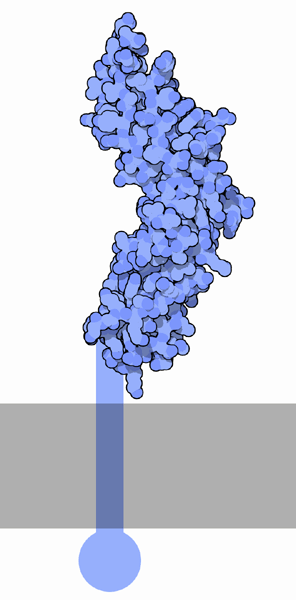|
Inhaltsübersicht | Nanomaschinen | Moleküle | Programme | Kurse | Fun | Links |
||
| > |
Tissue Factor

Blood performs many essential jobs in your body: it transports oxygen and nutrients, it protects your cells from infection, and it carries hormones and other messages from place to place in your body. But since blood is a liquid that is pumped under pressure, we must protect ourselves from leaks. Fortunately, the blood has a built-in repair method that quickly stops up breaks in the blood circulatory system as soon as they happen. You see these repairs in action whenever you cut yourself: the blood thickens and forms a gooey clot, which then dries into a scab that seals and protects the cut until it can heal.
To Clot or Not?
Blood clotting is a tricky business. All of the building blocks for a clot must be present all the time, so that they can instantly jump into action when damage occurs. But this must be done carefully and only at exactly the right time. If clots form in the wrong places, they could block the normal flow of blood, which could then cause heart attacks or strokes. Tissue factor is one of the molecules that triggers the formation of a clot when the time is right.
Inside Meets Outside
Your body uses a very simple method to sense when damage occurs. The cells in the neighborhood around blood vessels have tissue factor on their surfaces, but the cells that line the blood vessels do not. Most of the time, the blood flows smoothly through the vessels and never comes in contact with tissue factor. However, when you cut yourself, blood flows out of the vessels and into places that it shouldn't be. Then, it comes into contact with tissue factor, which starts the cascade that clots the escaping blood.
Looking at Tissue Factor
Tissue factor is a sausage-shaped protein that is tethered to the surface of cells. PDB entries 2hft (shown here) and 1boy show just the part on the outside of the cell. In the full-size protein, there is also a segment that crosses through the cell membrane and a small portion inside the cell. The portion outside is the part that interacts with the blood clotting machinery. The little bit inside, however, plays its own role in cell signaling. It is thought to be important for the control of cell migration as the wound is healing and new blood vessels are being built.
Next: Clotting Cascade
Last changed by: A.Honegger,